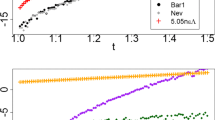Abstract
We study two criteria to evaluate quadrature formulas when used in automatic quadrature programs. The former consists of the computation of a quantity depending on both the truncation error behavior and the geometric properties of the nodes of the rule. This measure allows estimating the asymptotical computational cost in various abstract models of automatic quadrature. The latter is a testing technique which can be used to measure the efficiency of the formulas under consideration in a real environment. The relationships between the two criteria are investigated and the two approaches seem in good agreement.
Similar content being viewed by others
References
P. Davis and P. Rabinowitz,Methods of Numerical Integration, Academic Press, New York, 1984.
P. Favati, G. Lotti, and F. Romani,Testing automatic quadrature programs, Calcolo, 27 (1990), pp. 269–193.
P. Favati, G. Lotti, and F. Romani,Interpolatory integration formulas for optimal composition, ACM Trans. Math. Software, 17 (1991), pp. 207–217.
P. Favati, G. Lotti, and F. Romani,ALGORITHM 691: Improving QUADPACK automatic integration routines, ACM Trans. Math. Software, 17 (1991), pp. 218–232.
P. Favati, G. Lotti, and F. Romani,Asymptotic expansion of error in interpolatory quadrature. Comp. Math. Appl., 24 (1992), pp. 99–104.
G. Di Marco, P. Favati, G. Lotti, and F. Romani,Asymptotic behaviour of automatic quadrature. To appear in J. Complexity.
J. N. Lyness and J. J. Kaganove,A technique for comparing automatic quadrature routines. Comp. J., 20 (1977), pp. 170–177.
M. A. Malcolm and R. B. Simpson,Local versus global strategies for adaptive quadrature. ACM Trans. Math. Software, 1 (1975), pp. 129–146.
P. Piessens, E. De Doncker-Kapenga, C. Überhuber, and D. K. Kahaner,QUADPACK: A Subroutine Package for Automatic Integration, Springer, Berlin, 1983.
H. Sugiura and T. Sakurai,On the construction of high-order integration formulae for the adaptive quadrature method, J. Comp. Appl. Math., 28 (1989), pp. 367–381.
Author information
Authors and Affiliations
Additional information
Work supported by CNR, Grant No. 93.00570.CT01.
Rights and permissions
About this article
Cite this article
Favati, P., Lotti, G. & Romani, F. Theoretical and practical efficiency measures for symmetric interpolatory quadrature formulas. BIT 34, 546–557 (1994). https://doi.org/10.1007/BF01934267
Received:
Revised:
Issue Date:
DOI: https://doi.org/10.1007/BF01934267



